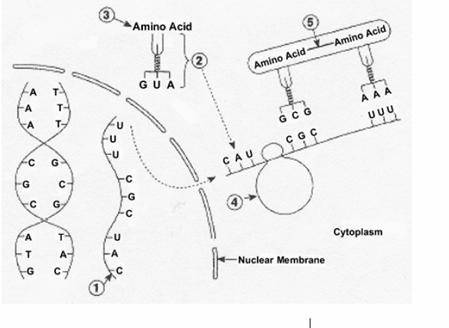
Biology, 28.11.2020 03:00 anonymous176
18. Number 1 in the diagram above is a representation of a/an _ (1)
19. Number 2 in the diagram above is a representation of a/an _ (1)
20. Number 4 in the diagram above is a representation of a/an _or _ (2)
21. Number 5 in the diagram above is a representation of a/an _ (1)
22. Which type of RNA take the DNA code to the ribosome? _ (1)
23. The parts of DNA that provide the code for proteins are the _ _ (1)
24. When mRNA is made, thymine is replaced with what base? _ (1)
25. Which type of RNA make up the ribosomes? _ (1)
26. Where in the cell does transcription take place? _ (1)
27. Where in the cell does translation take place? _ (1)
28. What kind of RNA makes a complimentary copy of DNA? _ (1)


Answers: 2
Another question on Biology

Biology, 21.06.2019 20:30
For your initial isolation of the bacterium, you simply needed to grow enough of it that you could identify some of its more general features. thus, you used a complex nutrient agar that would allow for the growth of almost any bacterial species. different bacterial species often have very specific requirements for life. this is a fact that you can utilize when you are trying to identify the bacterium to the species level. growth conditions that will permit the growth of one species but not another may allow you to select which one you would like to culture. you can utilize different selective/differential media that allow for the growth of only one type of bacteria (e.g., either gram positive or gram negative). culturing media such as phenylethyl alcohol or sodium chloride agar will be selective/differential for gram-positive bacteria. you may also want to show that it is different from other bacteria that may be present, so you could use a selective/differential agar. selective/differential media such as blood agar or phenol red sugar broths allow for the determination of whether a bacterial cell can grow and utilize specific ingredients included in the medium and turn the agar a distinct color. sheep's blood agar utilizes red blood cells to differentiate which bacterial species may have hemolytic properties.selective or differential? 1. an agar that uses a high salt concentration to limit the growth of one type of bacteria over another would be considered selective/differential. 2. if an agar contains a dye or ph indicator in the presence of a sugar, it is generally considered selective/differential for those bacteria that may ferment the sugar over those that cannot. 3. an agar that uses the dye in crystal violet agar suppresses the growth of gram-positive bacteria. this agar would be considered selective/differential. 4. the selective/differential aspect of macconkey agar allows for the determination of which bacteria are lactose fermenters and which are not. 5. a blood agar plate contains sheep red blood cells and allows for the determination of hemolytic capabilities for all bacteria that grow on the agar. this would make this type of agar selective/differential. 6. emb agar uses lactose and two dyes that allow it to be selective/differential between the blue-black colonies of e. coli and the pinkish colonies of all other enteric bacteria. 7. bile salts in macconkey agar allow for the agar to be selective/differential for the growth of enteric gram-negative bacteria over gram-positive bacteria. 8. an agar that allows for the distinction of bacteria based on metabolism would be considered selective/differential.
Answers: 1

Biology, 22.06.2019 07:00
Which best describes a gene? a. a sister chromatid b. a chromosome c. a tetrad d. a piece of a chromosome
Answers: 2

Biology, 22.06.2019 08:10
In sweet pea, gene c is responsible for color production and gene p is responsible for the purple color pigment. both of them are located on two different loci on different chromosomes. the flowers will be purple only when the plant has the genotypes as c_p_. no color will be produced with genotypes: ccpp, ccpp, ccpp, ccpp. thus, gene c controls the expression of gene p. what pattern of inheritance is exhibited here? a. pleiotropy b. epistasis c. multiple alleles
Answers: 1

Biology, 22.06.2019 08:50
If the nucleus of a cell was removed the cell wouldn’t be able to make proteins because
Answers: 1
You know the right answer?
18. Number 1 in the diagram above is a representation of a/an _ (1)
19. Number 2 in the diagram abo...
Questions


Physics, 31.03.2021 18:50

Mathematics, 31.03.2021 18:50



History, 31.03.2021 18:50

Mathematics, 31.03.2021 18:50

Mathematics, 31.03.2021 18:50

Mathematics, 31.03.2021 18:50



Mathematics, 31.03.2021 18:50

History, 31.03.2021 18:50

Mathematics, 31.03.2021 18:50


Mathematics, 31.03.2021 18:50




Mathematics, 31.03.2021 18:50



